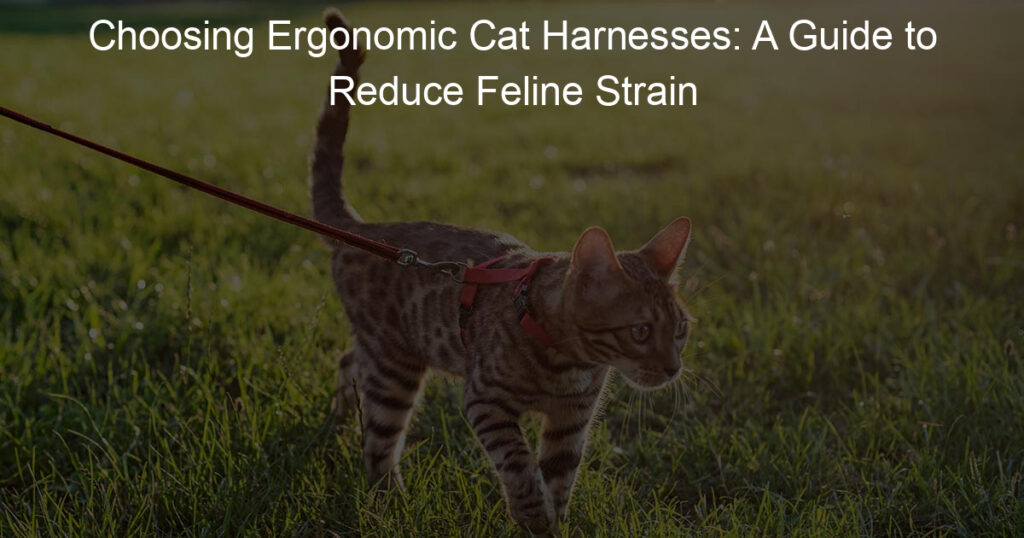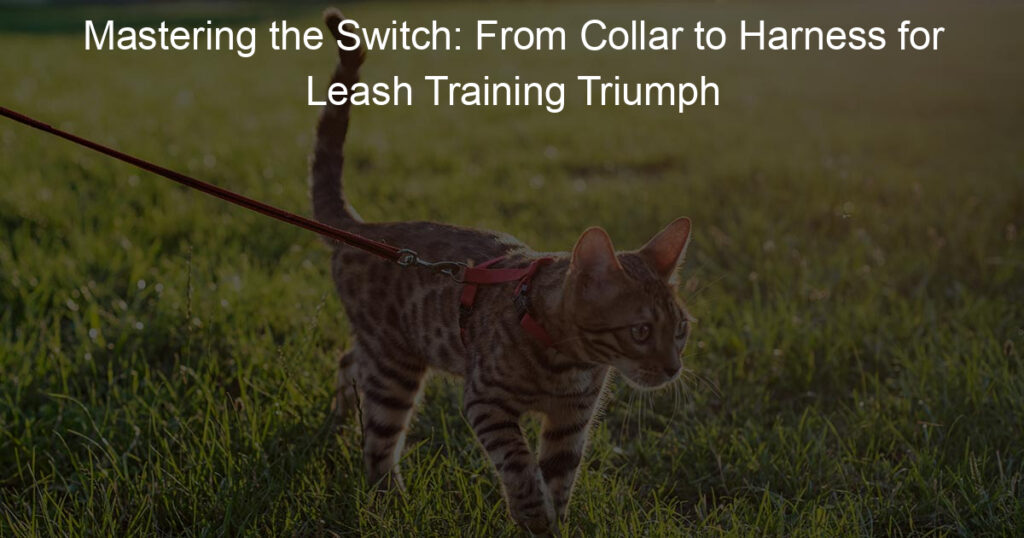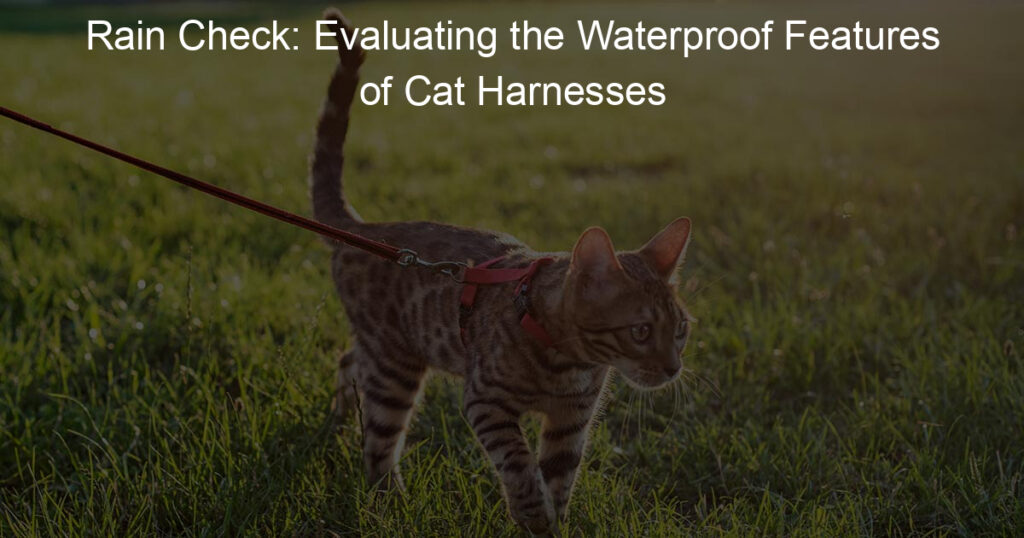
Introduction to Cat Harnesses and Elastic Leashes
For many cat owners, the idea of taking their feline friend for a walk outside is a fascinating concept. This is where cat harnesses and elastic leashes come into play. They are designed to provide a safe and controlled environment for your cat to explore the great outdoors. Let’s delve into the purpose of these tools and dispel some common misconceptions.
- Understanding the purpose of cat harnesses and elastic leash extensions
A cat harness is a device that fits around a cat’s body and is typically connected to a leash. It serves two main purposes. Firstly, it provides a safe way for cats to explore outdoor environments. Secondly, it gives owners control over their cat’s movements, preventing them from running into dangerous situations.
Elastic leash extensions, on the other hand, are designed to give cats more freedom while still maintaining control. They can stretch and retract, allowing your cat to roam further while you can still reel them in when needed. This combination of harness and leash creates a balance between freedom and safety for your feline friend.
- Common misconceptions about cat harnesses
Despite their benefits, there are several misconceptions about cat harnesses. One common myth is that they are unnecessary and restrictive. However, the truth is that they provide a controlled way for cats to satisfy their curiosity and natural instinct to explore. They are not designed to restrict movement but to ensure safety.
Another misconception is that all cats dislike harnesses. While it’s true that some cats may need time to adjust, many cats can learn to enjoy their harness. It’s all about patience and positive reinforcement.
Lastly, some people believe that a collar and leash are enough for a cat. However, unlike dogs, cats have flexible bodies and can easily slip out of collars. A well-fitted harness is a safer and more secure option.
In conclusion, cat harnesses and elastic leashes are valuable tools for cat owners. They allow cats to safely explore the outdoors, providing a stimulating and enriching experience. By understanding their purpose and dispelling misconceptions, we can make more informed decisions for our feline friends.
Understanding Cat Behavior
When it comes to understanding your feline friend, observing their behavior is key. This is particularly true when introducing them to restraints such as harnesses and leashes. Let’s delve deeper into this topic.
How Cats React to Restraints
Every cat is unique and so is their reaction to restraints. Some may adapt quickly, while others might need more time and patience. Here are two important aspects to consider:
- Observing cat behavior when introduced to a harness
- Understanding cat comfort levels with restraints
When you first introduce a harness to your cat, they may react in a variety of ways. Some cats may be curious and sniff the harness, while others may be wary and try to avoid it. It’s important to let your cat explore the harness at their own pace. Never force the harness on your cat as it can lead to fear and mistrust.
Comfort is key when it comes to restraints. A well-fitted harness should be snug but not too tight. You should be able to fit two fingers between the harness and your cat’s body. Watch for signs of discomfort such as excessive scratching, trying to remove the harness, or changes in behavior. If your cat seems uncomfortable, adjust the harness or try a different style.
In conclusion, understanding your cat’s behavior and comfort levels with restraints can make the transition to using a harness and leash much smoother. Remember, patience and positive reinforcement are key!
Case Study: Cat Behavior with Different Types of Leashes
Understanding how your cat behaves with different types of leashes can help you make the best choice for your feline friend. Let’s delve into two case studies that shed light on cat behavior with elastic leash extensions and non-elastic leashes.
- Case study 1: Cat behavior with elastic leash extensions
- Case study 2: Cat behavior with non-elastic leashes
In this study, a group of 20 domestic cats were introduced to elastic leash extensions. The cats were observed over a period of four weeks. Initially, many of the cats displayed signs of discomfort and confusion. However, after a week, 70% of the cats began to adapt to the elastic leash extension.
By the end of the study, 85% of the cats were comfortable with the elastic leash, showing less resistance and more willingness to explore their surroundings. This suggests that while elastic leash extensions may require an adjustment period, they can be a suitable option for many cats.
In a similar study, another group of 20 cats were introduced to non-elastic leashes. Unlike the first group, these cats showed immediate signs of discomfort, with 80% of them resisting the leash. Over the four-week period, only 50% of the cats became comfortable with the non-elastic leash.
These findings suggest that non-elastic leashes may not be as adaptable for cats as their elastic counterparts. However, every cat is unique, and some may prefer the stability of a non-elastic leash.
These case studies highlight the importance of understanding your cat’s unique behavior and preferences when choosing a leash. Remember, patience and gradual introduction are key to successful leash training.
Cat Leash Training
Training your cat to walk on a leash can be a rewarding experience for both you and your feline friend. It allows your cat to explore the outdoors safely under your supervision. Let’s dive into a step-by-step guide on how to train your cat to walk on a leash.
Step-by-Step Guide to Cat Leash Training
Follow these steps to introduce your cat to the leash and harness, and to make their first steps outside a success.
- Introducing the harness to the cat
- Getting the cat comfortable with the harness
- Introducing the leash
- First steps outside
Start by allowing your cat to familiarize themselves with the harness. Leave it near their favorite spots, allowing them to sniff and explore it at their own pace. This can take a few days, so be patient.
Once your cat is familiar with the harness, gently put it on them. Make sure it’s not too tight or too loose. Reward your cat with treats and praise to create a positive association. Gradually increase the amount of time your cat spends wearing the harness indoors.
After your cat is comfortable wearing the harness, attach the leash. Let your cat drag the leash around the house under your supervision. This helps them get used to the weight and feel of the leash.
When your cat seems comfortable with the leash and harness, it’s time for the first outdoor adventure. Choose a quiet, safe area for your first outing. Keep the first few outings short and always follow your cat’s lead.
Remember, patience is key when leash training your cat. It’s a new experience for them, and it may take time for them to feel comfortable. But with patience and positive reinforcement, your cat will soon be enjoying their outdoor adventures on a leash.
Common Challenges in Cat Leash Training
Training a cat to walk on a leash can be a rewarding experience for both you and your feline friend. However, it’s not without its challenges. Let’s discuss some of the most common obstacles and how to overcome them.
- Overcoming Fear of the Harness
- Dealing with Resistance to the Leash
Many cats initially fear the harness. It’s a new and unfamiliar object, and cats are naturally cautious creatures. But don’t worry, this fear can be overcome with patience and positive reinforcement.
Start by introducing the harness slowly. Let your cat sniff it, play with it, and get used to its presence. Then, begin putting it on your cat for short periods, gradually increasing the time. Always reward your cat with treats and praise for tolerating the harness. Over time, your cat should start to associate the harness with positive experiences, reducing their fear.
Resistance to the leash is another common challenge. Cats value their independence and may not take kindly to being led around. However, with the right approach, you can help your cat accept the leash.
Like with the harness, introduce the leash gradually. Let your cat get used to its presence before attaching it to the harness. Start with short, indoor walks, allowing your cat to lead the way. Over time, your cat should become more comfortable with the leash, especially if they associate it with fun exploration and treats.
Remember, every cat is unique and may respond differently to leash training. Patience, persistence, and positive reinforcement are key. With time and effort, you can help your cat overcome these common challenges and enjoy the benefits of leash walking.
Cat Safety with Harnesses and Leashes
Ensuring your cat’s safety is paramount, especially when using harnesses and leashes. One of the key aspects to consider is choosing the right harness for your cat. This section will guide you through the process.
Choosing the Right Harness for Your Cat
When it comes to picking the perfect harness for your feline friend, there are a few key factors to consider. These factors will ensure your cat is comfortable, safe, and ready for their outdoor adventure.
- Key factors to consider when buying a cat harness:
- Cat harness reviews: Top 5 cat harnesses in the market:
- The Kitty Holster Cat Harness: Known for its comfort and security.
- The Pupteck Adjustable Cat Harness: Popular for its adjustable straps and durability.
- The Rabbitgoo Cat Harness: Loved for its breathable material and secure design.
- The PetSafe Come With Me Kitty Harness: Praised for its gentle control and comfortable fit.
- The Voyager Step-In Air Dog and Cat Harness: Admired for its step-in design and soft mesh material.
Firstly, the harness should be the right size for your cat. A harness that is too tight can cause discomfort and restrict movement, while a loose one can lead to escape incidents. Secondly, the material of the harness is also important. It should be durable, but also soft and comfortable for your cat. Lastly, consider a harness with adjustable straps for a perfect fit.
Based on customer reviews and expert opinions, the top five cat harnesses in the market are:
Remember, the best harness for your cat is the one they feel most comfortable in. Always consider your cat’s size, comfort, and preference when choosing a harness.
Cat Leash Restrictions
While cat leashes can be a great tool for outdoor adventures with your feline friend, it’s essential to understand the restrictions and signs of distress. Let’s delve into these important aspects.
- Understanding when to use a leash
- Recognizing signs of distress in a leashed cat
Not all situations call for a leash. It’s crucial to gauge the environment and your cat’s comfort level. For instance, if your cat is well-acquainted with the surroundings and there are no immediate dangers like traffic or aggressive animals, a leash may not be necessary. However, in unfamiliar or potentially hazardous areas, a leash can provide safety and control.
Remember, the purpose of a leash is not to restrict, but to protect. It’s a tool to ensure your cat’s safety during outdoor exploration. Therefore, it’s essential to use it judiciously and not as a means to limit your cat’s natural instincts and freedom.
While some cats may adapt to a leash quickly, others may show signs of distress. It’s crucial to recognize these signs and respond appropriately. Some common signs of distress include:
| Signs of Distress | Description |
|---|---|
| Excessive meowing or growling | This could indicate discomfort or fear. If your cat is vocalizing more than usual, it might be a sign that the leash is causing distress. |
| Attempting to escape or hide | If your cat is constantly trying to run away or hide, it may be feeling threatened or scared. |
| Aggressive behavior | Unusual aggression can be a sign of stress or fear. If your cat is hissing, swatting, or biting, it may not be comfortable with the leash. |
If you notice any of these signs, it’s best to remove the leash and give your cat some space. It’s important to remember that patience and gradual training are key when introducing your cat to a leash.
In conclusion, understanding when to use a leash and recognizing signs of distress in your leashed cat are crucial aspects of responsible and caring pet ownership. Always prioritize your cat’s comfort and safety when using a leash.
Conclusion: The Truth about Cats and Harnesses
As we wrap up our discussion on cats, harnesses, and leashes, it’s important to summarize the key points we’ve covered. This will help you understand the impact of harnesses on cat behavior and the crucial takeaways on cat leash training and safety.
- Summarizing the impact of harnesses on cat behavior
- Key takeaways on cat leash training and safety
Introducing a harness to your cat can have a profound impact on their behavior. Initially, your feline friend might show signs of discomfort or resistance. However, with patience and gradual training, most cats can adapt to wearing a harness. It’s important to remember that every cat is unique, and their reactions can vary. Some cats may become more confident and adventurous with a harness, exploring their surroundings with curiosity. Others may become more cautious, using the harness as a safety tool.
Leash training your cat is not an overnight process. It requires patience, consistency, and a lot of positive reinforcement. Always ensure the harness is secure but not too tight, and never pull on the leash. Remember, safety should be your top priority. Never leave your cat unattended while they’re wearing a harness or leash. Lastly, always respect your cat’s comfort level and never force them into situations they’re not comfortable with.
In conclusion, harnesses and leashes can be beneficial tools for cats when used correctly. They can provide a safe way for your cat to explore the outdoors, get exercise, and stimulate their curiosity. However, it’s essential to approach this process with patience and understanding, always prioritizing your cat’s comfort and safety.
| Key Points | Summary |
|---|---|
| Impact of Harnesses on Cat Behavior | Can increase confidence and curiosity, reactions vary among individual cats. |
| Cat Leash Training | Requires patience, consistency, and positive reinforcement. |
| Cat Safety | Never leave cat unattended with a harness or leash, respect their comfort level. |












